
Villarreal is a city and municipality in the province of Castellón which is part of the Valencian Community in the east of Spain.

Ontinyent is a municipality in the comarca of Vall d'Albaida, Valencian Community, Spain. It is situated on the banks of the Clariano River, a tributary of the Xúquer, and on the Xàtiva–Alcoi railway. Ontinyent is near the Sierra de Mariola Natural Park.

Benimaclet is a former village which is now part of the city of Valencia, Spain. The placename is of Arabic origin dating from Moorish times. It is located in the north east of the city and borders the districts of Orriols in the west, Alboraia in the north, the University of Valencia district in the East and the Primat Reig area in the south. Benimaclet is, by extension, the name of the postal district 46020 of the city of Valencia. This postal district unites the district with the recently urbanised neighbouring areas such as the Polytechnic University of Valencia district, which is known locally as camí de Vera. Extensive building in the last 30 years has meant that the final parts of the rural area known as l'horta have vanished in Benimaclet in recent years.
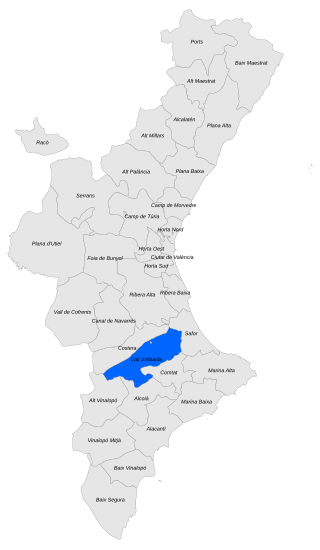
Vall d'Albaida is a comarca in the province of Valencia, Valencian Community, Spain.
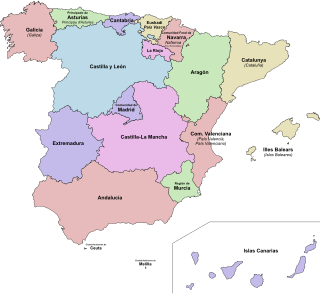
Jérica is a town in the Castellón province of Valencian Community, Spain. It is in the comarca (region) of Alto Palancia. Its population was 1,703 at the end of 2009.
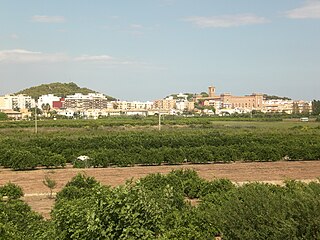
El Puig, officially El Puig de Santa Maria since 2012, is a village situated 15 km north of the city of Valencia in the comarca of Horta Nord, Spain. Its name means "hill" in Valencian). The municipality comprises three main areas, the first being the village itself, which is dominated by a monastery, and two large wooded hills next to it, the largest of which has the ruins of a castle fortress at the top. Originally, however, there was another hill named La Pedrera which disappeared gradually during the 20th century to make way for the V-21 motorway, with the rock being used to construct one of the jetties at Valencia's port. The second section is the coastal area of 4 km of beach with eight housing developments that are generally only inhabited in the summer; and finally, there is an industrial park located between them.

Ademuz is a municipality in the comarca of Rincón de Ademuz in the Valencian Community, Spain. The name in Valencian is Ademús, but the local language is Spanish, not Valencian.

Chella is a municipality in the comarca of Canal de Navarrés in the Valencian Community, Spain.
Chelva is a municipality in the comarca of Los Serranos in the Valencian Community, Spain. Its name in Valencian is Xelva, but the local language is Spanish and not Valencian.
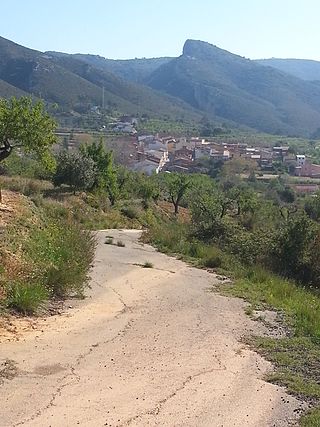
Pinet is a municipality located in the north-east of the comarca of Vall d'Albaida in the south of the province of Valencia, Valencian Community, Spain, and some 82.6 km from the regional capital, Valencia.

Quart de Poblet, or simply Quart, is a municipality in the comarca of Horta Oest in the Valencian Community, Spain. It has 25,499 inhabitants.

Simat de la Valldigna is a municipality in the comarca of Safor in the Valencian Community, Spain. It is 50 km from Valencia, and 20 km from Cullera and Gandia. It is also near Xàtiva and Alzira.

La Yesa is a small town and municipality in the comarca of Los Serranos in the Valencian Community, Spain. The name in Valencian is La Iessa, but the local language is Spanish, not Valencian.

Viver is a town in the Castellón province of Valencian Community, Spain. It is in the comarca (region) of Alto Palancia.

Morella is an ancient walled city located on a hill-top in the province of Castellón, Valencian Community, Spain. The town is the capital and administrative centre of the comarca of Els Ports, in the historic Maestrat (Maestrazgo) region.

La Vall d'Uixó is a town situated in eastern Spain, in the Valencian province of Castelló. La Vall is located 25 km to the south of the province's capital Castelló, 45 km to the north of the community's capital Valencia and 8 km to the Mediterranean Sea, and sits at 118 m above sea level.
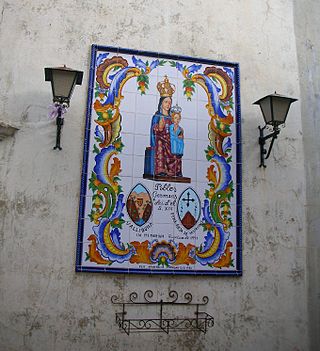
Vallibona is a small town and municipality located in the Ports comarca, province of Castelló, part of the autonomous community of Valencia, Spain. According to the 2009 census, it has a total population of 90 inhabitants. It is located in the upper valley of the Cérvol River, between the Serra del Turmell and the Ports de Beseit mountain ranges, in a very lonely area, relatively far from other towns. Vallibona is part of the Taula del Sénia free association of municipalities.

Valencians are the native people of the Valencian Community, in eastern Spain. Since 2006, the Valencian people are officially recognised in the Valencian Statute of Autonomy as a nationality "within the unity of the Spanish nation". The official languages of Valencia are Valencian and Spanish.

Serra de l'Espadella is an over 4 km (2 mi) long mountain range in the Baix Maestrat comarca, Valencian Community, Spain. Its highest point is Espadella. These mountains are frequently covered in snow in the winter.
Xilxes (Valencian) or Chilches (Spanish) is a municipality located in the province of Castellón, Valencian Community, Spain.






















